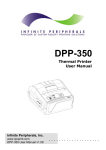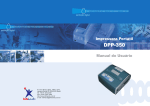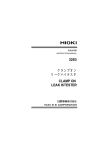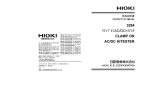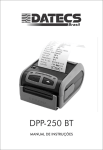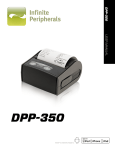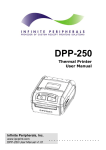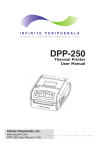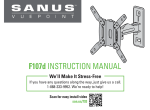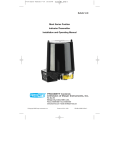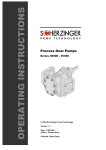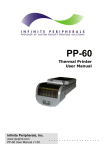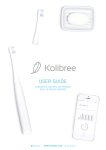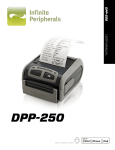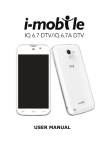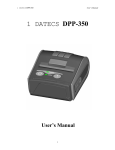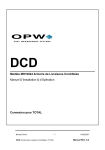Download DPP-350
Transcript
DPP-350 ESC/POS Thermal Printer User’s Manual The information in this document cannot be reproduced in any mechanical, electrical or electronic way and under any circumstances without the written consent from Datecs Ltd. 1784 Sofia, Bulgaria, tel: +359 2 974 00 55, fax: +359 2 974 11 00 e-mail: [email protected] Version 04.2009 (1.50) Page 2 DPP-350 User Manual .................... Contents Technical Data .............................................................................4 Box Contents ...............................................................................6 Compatible Devices ......................................................................7 Getting Started ............................................................................8 About Your DPP-350 .....................................................................9 Charging the DPP-350................................................................. 10 Status & Operating Modes ........................................................... 11 Loading Paper ............................................................................ 12 Power On Self-test ..................................................................... 13 Self-test .................................................................................... 14 Dip Switch Settings .................................................................... 15 DIP Switch Location .................................................................... 16 Printer Configuration................................................................... 17 Connecting Device ...................................................................... 18 Bluetooth® Setup ....................................................................... 23 Loading Drivers.......................................................................... 24 Magnetic Card Reader (MS Version).............................................. 25 Smart Card Reader (SC Version) .................................................. 26 MIFARE Reader (MF Version) ....................................................... 27 Replacing Battery ....................................................................... 28 Developing Solution.................................................................... 29 Troubleshooting ......................................................................... 30 List of commands for ESC/POS mode ............................................ 31 Page 3 DPP-350 User Manual .................... Technical Data Feature Specification Emulation ESC/POS Printer mechanism FTP-638MCL103 Printing Method Thermal-line dot method Dot structure 576 dots per line Dot pitch (Horizontal) 0.125 mm (8 dots/mm) - Dot density Dot pitch (Vertical) 0.125 mm (8 dots/mm) - Line feed pitch Effective printing area max 72 mm Paper Feed System step Printing Speed Maximum 60mm/sec. (480 dot line/sec.) at 8.5 V Head life * Pulse resistance: 100 million pulses/dot (under our standard conditions). * Abrasion resistance: paper traveling distance 50km (print ratio: 25% or less) Font А: 12 x 24 dots, 48 characters per line Font B: 9 x 16 dots, 64 characters per line Loadable Font C: 12 x 24 dots, 48 char. per line Fonts Loadable Font D: 9 x 16 dots, 64 char. per line Font E (JIS and Shift-JIS): 24 x 24 dots, 28 characters per line - Japanese version only Logo Registration Barcode printing FLASH Memory Font F (GB2312): 24 x 24 dots, 28 characters per line - Chinese version only 1 Black & White BMP format ( 1-bit per pixel); Size: 576 x 248 EAN 13, EAN 8, UPC-A, UPC-E, CODEBAR, CODE 39, CODE 128, PDF417, QR Code 1 Mega bit RAM Memory 36 864 bytes (option 131 072 bytes) Interfaces RS-232 interface, type RS-232C, max 115200 bps Page 4 DPP-350 User Manual .................... USB interface, type USB v 1.1, compatible with 2.0 Bluetooth interface (optional) RS-232 interface cable Cables mini USB А to mini USB B cable (optional) Magnetic Card Reader - 3 track head, ISO7811 (optional) Configuration options Smart Card Reader, ISO 7816-1/2/3 (optional) MIFARE Reader, ISO 14443-A (optional) SD card slot for SD card (optional) Battery Rechargeable Li-ion battery - 7.4 V / 2 Ah Battery capacity: Print 30 000 lines per charge Power supply AC adapter, model: SA110C Input: AC 100 – 240 V / 0.3 A ; 50/60 Hz Output: DC 9 V / 1 A Power switch ON/OFF Operation switches Width, mm Recommended Diameter, mm Paper Thickness, µ m Button LF – Paper feed, Self test, Dump mode Button ON/OFF- Switch On and Switch OFF 80 or 58 / 60 50 60 to 100 (some paper in this range may not be used because of paper characteristics) Dimensions, (W x D x H) mm 108 x 111 x 62 Weight, g 400 (w/o paper) 460 (with paper) Safety standards and EMI Operating environment "Drop" test – up to 110 cm and "Waterproof" Operating temperature humidity 0°C to + 50°C 20 to 85% RH (no condensation) Storage temperature humidity -20°C to + 60°C 5 to 95% RH (no condensation) Table 1 Page 5 DPP-350 User Manual .................... Box Contents Your DPP-350 comes with the following items listed below: Item 1 Part Number DPP-350xx Descriptions Image DPP-350 Thermal printer 2 - AC charger 3 - 1 Roll of thermal paper 4 - User's manual 5 - 6 - RS232 Interface cable Partition (2 pcs) for 58/60mm X 50mm diameter paper rolls* Table 2 * With the help of 2 pcs. Partition for 58/60mm wide paper roll DPP-350 printer can be used with different width paper rolls. 1. Turn off the printer power. 2. Open the paper cover. 3. Attach the 2 pcs. “Partition” supplied with the printer to the holes in bottom of printer. By switching places of the two “Partition” can be used either 58mm or 60mm wide paper rolls 4. Referring to the section of DIP switch setting change the paper width setting to 58 mm. Software ( Drivers & SDK ): Because of the continually evolving Driver & SDK to support new mobile devices, Drivers & SDK are distributed online and is available for download at our website indicated below. For details on using the DPP-350 Drivers & SDK, please refer to the SDK’s documentation. http://datecs.bg/support.php?cat=4&soft=1#1 Page 6 DPP-350 User Manual .................... Compatible Devices The DPP-350 (Serial & USB) / DPP-350 (Bluetooth®) portable ESC/POS thermal printer is designed specifically for use with most PDA & Smartphone devices. The DPP-350 can be used in a variety of applications where Printing / Card Reading is required. User Notes: Compatibility depends on the type of communication method “Serial / USB / Bluetooth®” your PDA or Smarphone supports and the availability of DPP-350 driver for your device. • Determine the method of communications your device supports. • Next determine if your device is supported by the DPP-350 Drivers & SDKs. Because of the continually evolving Driver & SDK to support new mobile devices, visit our developer web site at: http://datecs.bg/support.php?cat=4&soft=1#1 Page 7 DPP-350 User Manual .................... Getting Started The DPP-350 allows you to printer information from your PDA & Smartphone. Before using the DPP-350 thermal printer the battery should be properly charged. The following Quick Start guide will help to get your DPP-350 ready for use. Quick Start: What to do 1 Charge the DPP-350 rechargeable battery pack as recommended in this manual. The Lithium Ion battery pack should be fully charged before use to ensure long battery life. Charging Battery, Page 9 2 Load DPP-350 print media (Thermal Paper) DPP-350 requires Thermal paper for printing. Loading Paper, Page 11 Setup Bluetooth Pairing. Setup Bluetooth® pairing to allow DPP-350 to communicate with ® Bluetooth devices. Bluetooth Setup, Page 16 3 4 Install DPP-350 Software Purpose Where to find more information Steps To print information from your device, software needs to be installed onto your device. ® Printing software is not provided by Datecs. Please contact your DPP350 reseller for recommendations on Third-Party solutions. Developers should refer to the section in this manual on “Developing Solutions”. Table 3 Page 8 DPP-350 User Manual .................... About Your DPP-350 ♦ DPP-350 left view Paper Cover Lever Power On/Off Switch Paper Feed (LF) Magnetic Card Reader Serial RS232 Mi Fare Reader (Optional) Figure 1 ♦ DPP-350 right view Status (ON/OFF & Error) LED Magnetic Card Reader Activation LED Charging LED Mini USB Port Charger Input Smart Card Reader (Optional) Figure 2 Page 9 DPP-350 User Manual .................... Charging the DPP-350 The DPP-350 uses a Lithium Ion rechargeable battery pack. Before first use, the DPP-350 battery pack should be charged for at least 4 hours. To prevent electrical damage to the DPP-350 and/or battery pack, please use approved AC Charger only. Solid RED = charging Solid GREEN = fully charged (~4 hrs.) AC Charger Figure 3 Page 10 DPP-350 User Manual .................... Status & Operating Modes The DPP-350 uses LEDs to indicate various conditions of operation. This may be charging, active or online, battery low conditions. The following explains these conditions and LED indication. Charging LED Line Feed (LF) Button Power Button ON/OFF Figure 4 Status (ON/OFF & Error) LED Printer Status Charging LED Status (ON/OFF & Error ) LED Solid GREEN = Battery at full charge Solid RED = Battery charging Flashing once per second = Power ON Flashing once per second = Error condition(s) • Low battery • No Paper • Thermal Head Overheating Table 4 Page 11 DPP-350 User Manual .................... Loading Paper The DPP-350 uses a drop-and-load design making paper loading easy and trouble free. To load paper, simply lift up the paper cover latch and drop in the new roll as shown in the steps below. 1. Lift the paper cover latch to unlock the paper cover as shown in the figure on the right. F igure 5 2. Lift the paper cover. 3. Drop in the new roll of thermal paper media as shown in the figure on the left. Be sure to pull at lease ½ inch or more of media above the top of the printer before closing. Figure 6 4. Close the paper cover until it snaps lock. Figure 7 Page 12 DPP-350 User Manual .................... Power On Self-test The DPP350’s LF switch/button is used for entering various printer modes. These modes can be used to assist developers in debugging problems related to programming and communication. The following explain how to access the various operating modes. Step #1: Make sure the printer is OFF (On-line LED is OFF) before performing step #2. Step #2: Press and hold the line feed button (LF). While pressing the (LF) button, press the (ON) button momentarily and release when the Status LED turns green. Release LF button after the printer Beep once. Shortly after the LF button is released the printer will print self-test. LF Button Operation Modes Short Push Push and Hold release after the number of beeps N/A Paper feed 1 - beep Self-test print 2 - beeps Hex Dump mode 3 - beeps Long-test print 4 - beeps Program mode Table 5 Note: Care must be taken when entering operating modes to prevent the clearing of factory preset configuration information. Page 13 DPP-350 User Manual .................... Self-test The DPP-350 has a built-in test pattern that shows the printer’s current configuration as well as the various resident printer fonts. The self-test can also be used as a troubleshooting tool to determine printing problems or battery level. The steps below show how the self-test is printed activated. • Resident font sizes • Characters per line • Text formatting • Resident character set • Resident barcode symbols • Printer’s Configuration Figure 8 Page 14 DPP-350 User Manual .................... Dip Switch Settings The DPP-350 is designed to use different methods of communications. Care must be taken to ensure that the DIP Switches are not changed from its default factory configuration unless required. ♦ DIP SWITCH SETTINGS: The printer has two absolutely different operation modes. They are determined by the state of switch Sw2: • • OFF ESC/POS mode ON Hex Dump mode Switch OFF ON Sw1 Wide paper roll (78 mm) Thinner paper roll (58 mm) Sw2 ESC/POS mode Hex Dump mode Sw3 Hardware protocol Xon/Xoff protocol Sw4 Normal operation mode Protocol mode Table 6 Page 15 DPP-350 User Manual .................... DIP Switch Location Figure 9 DIP Switch Figure 10 Page 16 DPP-350 User Manual .................... Printer Configuration The DPP-350 uses nonvolatile memory for storing some of the printer default configuration. The following table shows the available options. Memory Switch Options Memory Switch (see command reference GS command) 1000000010 BAUD RATE 115200 bps POWER OFF TIME 10 minutes PRINT DENSITY 100% CHARACTER TABLE WESTERN (1252) Table 7 Step #1: Make sure the printer is OFF (On-line LED is OFF) before performing step #2. Step #2: Press and hold the Power (ON) button. The Status LED flashes Green and after about 4 seconds holding the Power button the Status LED flashes Red and then turns Red. Release the button and wait for the printer to print out the current memory switch settings and instructions. Follow the printed instructions to make the necessary changes. Note: Care must be taken when changing factory preset configuration information. Page 17 DPP-350 User Manual .................... Setting Memory Switch ♦ MEMORY SWITCH SETTINGS: Step #1: Make sure the printer is OFF (STATUS LED is OFF) before performing step #2. Step #2: Press and hold the Power (ON) button. The Status LED flashes Green and after about 4 seconds holding the Power button the Status LED flashes Red and then turns solid Red. Step #3: Release the button and wait for the printer to print out the current memory switch settings and instructions. Follow the printed instructions to make the necessary changes. Note: Care must be taken when changing factory preset configuration information. Page 18 DPP-350 User Manual .................... Memory Switch Details ♦ SW1: ♦ SW2: Execute <CR> Carriage Return as <LF> Line Feed. ♦ SW3: Disable <LF> Line Feed command. Enable/Disable buzzer. ♦ SW4-7: Reserved for future features. ♦ SW8: ♦ SW9: ♦ SW10: (OFF) set USB as the host mode. Prevents others from discovering printer when set to ENABLE. Must be set after pairing is completed. Allow the use of USB port for communications. Page 19 DPP-350 User Manual .................... Pairing Info Details ♦ ♦ ♦ ♦ BAUD RATE: AUTO OFF TIME: PRINT DENSITY: CHARACTER TABLE: Default is 115200 Default is 5 minutes Default is 100% Default is WESTERN (1252) ♦ PAIRING INFO: DEFAULT is (SAVE = No) Notes: When saving pairing information, the printer remembers Bluetooth information of the last device connected (paired) to the printer. Saving pairing info prevents the printer from asking for passkey upon initialization. The process for using this option is described below. "To speed this programming process, you may bypass the memory switch settings by indicating "NO" via pressing of the <ON/OFF> button when the printer prints "CHANGE MEMORY SWITCHES" as shown on page 17. This will advance you to the next level of setting where pairing can be found". Saving Pairing Info: 1. 2. 3. Following instruction on page-17, change the Pairing Info option to [Save = Yes]. Turn the printer on and pair the printer to your Bluetooth device. The printer will now remember the pairing information and not prompt user for a passkey on every printer initialization. Clearing Pairing Info: 1. 2. 3. Following instruction on page-17, change the Pairing Info option to [Save = No]. Turn on the printer and pair the new Bluetooth device to the printer. The printer will prompt user for a passkey on every printer initialization. Page 20 DPP-350 User Manual .................... Communication Configuration The following standard configurations should be used for the different communication methods. ♦ Communication with PDA device ♦ Via Bluetooth/ USB/ Serial: Memory Switch Options Memory Switch ( 1 thru 10 ) *******010 (see page 16, 17, 18) Physical Switch Options DIP Switch (1, 2, 3 ,4) (see page 14) *, OFF, OFF, ON Table 8 ♦ Communication with PC (using windows printer driver) ♦ Via Bluetooth/ USB./ Serial: Memory Switch Options Memory Switch (1 thru 10) *******011 (see page 16, 17, 18) Physical Switch Options DIP Switch (1, 2, 3 ,4) (see page 14) *, OFF, OFF, OFF Table 9 ♦ ♦ Service mode (changing printer settings, loading firmware) communication with PC Via Serial Memory Switch Options Memory Switch ( 1 thru 10 ) *******011 (see page 16, 17, 18) Physical Switch Options DIP Switch (1, 2, 3 ,4) (see page 14) *, OFF, *, ON Table 10 * - depending on user requirements can be 1 or 0 Notes: When not using Driver/SDK developer tools, set DIP Switch 4 to OFF. Page 21 DPP-350 User Manual .................... Connecting Device The DPP-350 is designed to use different methods of communications. Care must be taken to ensure that the DPP-350 USB or Serial connector and PDA & Smartphone connector are not accidentally damaged. The figures below show how to attach the different device to the DPP-350. ♦ Serial / USB ( Cabled ) Version: • Connect the DPP-350 using Mini USB or Serial cable is shown in the figure below. USB Port Serial Port Figure 11 ® ♦ BLUETOOTH ( Wireless ) Version: • The DPP-350 Bluetooth® version uses Bluetooth® wireless technology to connect to Bluetooth® enable devices. See page 19 for details on Bluetooth® setup. Figure 12 Page 22 DPP-350 User Manual .................... Bluetooth® Setup Adding New Bluetooth® Device to PDA or Smartphones The following is a brief explanation on how to [Pair] your Bluetooth® DPP-350 to PDA & Smartphones. BlackBerry Devices: Add Device or Pairing Bluetooth® peripherals to BlackBerry devices require the use of the device Bluetooth® manager. Image on the right shows a typical Blackberry Bluetooth® manager. When adding / pairing the DPP-350, use the [0000] pairing key when prompted. Windows Mobile Devices: Creating a New Partnership or Pairing Bluetooth® peripherals to your Windows Mobile devices require the use of the device Bluetooth® manager. Image on the right shows a typical Windows Mobile Bluetooth® manager. When adding / pairing the DPP-350, use the [0000] pairing key when prompted. Palm Devices: Add Device or Pairing Bluetooth® peripherals to your Palm devices require the use of the device Bluetooth® manager. Image on the right shows a typical Palm Bluetooth® manager. When adding / pairing the DPP-350, use the [0000] pairing key when prompted. Page 23 DPP-350 User Manual .................... Loading Drivers Loading DPP-350 drivers for you’re PDA or Smartphones. BlackBerry Devices: Blackberry Desktop Manager shown in the figure on the right is used to load third party software on to your device. Please review your device’s documentation on how to use the Application Loader Option to load software on to your device. Windows Mobile Devices: Active Sync shown in the figure on the right is used to install third party applications on to your mobile device. Please review your device’s documentation on how to use the Active Sync Manager to load new software on to your device. In most cases you only need to run the DPP-350 installer to start the installation. Palm Devices: Palm Install Manager Application shown in the figure on the right is used to install third party applications on to your device. Please review your device’s documentation on how to use the Palm Install Manager Application to load new software on to your device. In most cases you only need to drag & drop DPP-350 PRC files in installer and click Add. Page 24 DPP-350 User Manual .................... Magnetic Card Reader (MS Version) The DPP-350 has a built-in magnetic card reader. The card reader incorporates a (3)-track magnetic read head requiring a single swipe to read field data from all three tracks. Magnetic Strip ( Face this direction ) Card Swipe Direction Magnetic Card Reader Figure 13 The reader’s magnetic head faces towards the front of the printer. When placing the card into the reader, the magnetic strip must be facing as show in the figure above. Keep the bottom edge of the card flat on the inner base of the reader to ensure that the magnetic strip passes over the read head evenly. When swiping the card through the reader, use an even consistent motion from start to finish. The speed of swiping can vary however the speed must be consistent from start to finish of the swipe in order to accurately read card data. User Notes: To use the magnetic card reader feature, special software must be used to read and process the card information. If you do not have card reading software, please consult your reseller to find out if this software is available or contact DATECS for recommendations on compatible third party software solutions. Page 25 DPP-350 User Manual .................... Smart Card Reader (SC Version) The DPP-350 has a built-in smart card reader (optional). The smart card reader is designed to read information stored embedded on smart chips and process the information using device side software. Smart Chip ( Face this direction ) Card Insert Direction Figure 14 When placing the card into the reader, the smart chip must be facing to the front of the printer as show in the figure above. Insert the card in to the reader until the card stops. User Notes: To use the smart card reader feature, special software must be used to read and process the smart chip information. Please con– sult your reseller if this software is available or contact DATECS for recommendations on compatible third party software solutions. Page 26 DPP-350 User Manual .................... MIFARE Reader (MF Version) The DPP-350 has a built-in MIFARE reader (optional). The MIFARE reader is designed to read information stored embedded on MIFARE contactless cards or tags and process the information using device side software. MIFARE card ) Figure 15 Place the MIFARE card close to the printer facing the front of the printer as shown in the figure above. User Notes: To use the MIFARE reader feature, special software must be used to read and process the card information. Please consult your reseller if this software is available or contact DATECS for recommendations on compatible third party software solutions. Page 27 DPP-350 User Manual .................... Replacing Battery To replace the battery in the DPP-350 thermal printer follow the steps below. Steps: 1. Turn over the DPP-350 and place on a flat surface. Rotate the (2) locking levers as shown in the figure on the right. Figure 16 2. Lift the battery cover as showed in the figure on the right. Figure 17 3. Lift the battery as shown in the figure on the right. Figure 18 4. Detach the battery connector as shown in the figure on the right. Reverse Steps 1-4 to install the new battery pack. Figure 19 Page 28 DPP-350 User Manual .................... Developing Solution Integrating the DPP-350 into your mobile solution requires the use of the DPP-350 PDA & Smartphone SDK. The SDK incorporates API specific to developing printing applications and using the integrated Magnetic Card Reader / Smart Card Reader / MIFARE Reader capability of the DPP-350. The table below shows the SDKs currently available for PDA & Smartphone devices. OS BlackBerry Palm One Windows Mobile Language Java C ++ Basic Basic VB.Net C ++ C Sharp SDK - IDE RIM BlackBerry Java JDE 4.1 and higher Code Warrior Satellite Forms NS Basic Microsoft Visual Studio 2005 (.Net) Microsoft Visual Studio 2005 (.Net) Microsoft Visual Studio 2005 (.Net) Table 13 For details on using the DPP-350 SDK, please refer to the SDK’s documentation. Page 29 DPP-350 User Manual .................... Troubleshooting If you’re having printing problem refer to the table below for possible causes. Item Problem Possible Cause 1 Paper feeds after issuing a print job but no printed text visible on paper. Thermal media is specially coated on outside of roll. Remove paper roll and reload properly. See section “Loading Paper” for details on loading paper. Paper cover not installed properly. See section “Loading Paper” for details on replacing paper cover. 2 On-line LED blinks RED continuously. 3 4 5 6 Strange characters are printed when printing. On-line LED always flashing RED Printer stops responding to print and paper feed commands. Printing is light or missing only on half of the print width. Battery voltage low. Printer out of paper or Paper not properly loaded. See section “Loading Paper” for details on loading paper. Battery voltage low. charging battery pack. See section on Battery voltage low, Paper empty or other error occurred. See section on charging battery pack or loading paper. Remove battery for reconnect battery. 5 seconds and Paper cover not properly installed. See section on loading paper. Mechanism jarred loose. Contact technical support. Table 14 Page 30 DPP-350 User Manual .................... List of commands for ESC/POS mode 1 BEL Sounds the buzzer 2 HT Horizontal Tab command 3 LF Printing а line and Paper Feeding command 4 FF Printing and paper feeding to the black mark position 5 CR The operation of the command depends on the state of the configuration flags 2, 3 and 4 6 DC2 = Image LSB/MSB select 7 DC3 ( DC3 (Ruled line) commands sequence start 8 DC3 + Sets the ruled line ON 9 DC3 - Sets the ruled line off 10 DC3 A Selects ruled line A 11 DC3 B Selects ruled line B 12 DC3 C Clears selected ruled line buffer 13 DC3 D Sets a single dot in selected ruled line buffer 14 DC3 F Ruled line pattern set 15 DC3 L Ruled line line set 16 DC3 M Selects ruled line combine mode 17 DC3 P Ruled line 1 dot line print 18 DC3 p Ruled line n dots line print 19 DC3 v Ruled line image write 20 CAN 21 ESC FF Printing data in page mode 22 ESC RS Sounds the buzzer 23 ESC SP 24 ESC # Setting EURO symbol position 25 ESC $ Specifying the absolute horizontal position of printing 26 ESC % Selecting/Canceling the printing of downloaded user character sets 27 ESC & Selecting user character set 28 ESC ! Specifying printing mode of text data 29 ESC * Printing graphical data 30 ESC + Switch’s OFF the printer Canceling print data in page mode Setting character spacing Page 31 DPP-350 User Manual .................... 31 ESC - Selecting/Canceling underlining 32 ESC . Printing self test/diagnostic information 33 ESC 2 Specifying 1/6-inch line feed rate 34 ESC 3 Specifying line feed rate n/203 inches 35 ESC < Changes print direction to opposite 36 ESC = Data input control 37 ESC > Selecting print direction 38 ESC ? Reading magnetic stripe card 39 ESC @ Initializing the printer 40 ESC CAL 41 ESC D Setting horizontal tab position 42 ESC E Specifying/Canceling highlighting 43 ESC F Filling or inverting the page area in page mode 44 ESC G Specifying/Canceling highlighting 45 ESC I Specifying/Canceling Italic print 46 ESC J Printing and Paper feed n/203 inches 47 ESC L Selecting page mode 48 ESC N Reading programmed serial number 49 ESC R Selecting country 50 ESC S Specifying speed (bps) of the serial port 51 ESC T Printing short self test 52 ESC U Selecting/Canceling underlined printing 53 ESC V Selecting/Canceling printing 90°- right turned characters 54 ESC W Defining the print area in page mode 55 ESC X Specifying max printing speed 56 ESC Y Selecting intensity level 57 ESC Z Returning diagnostic information 58 ESC \ Specifying relative horizontal position 59 ESC ] Loading the default settings stored in Flash memory 60 ESC ^ Saving current settings in Flash memory 61 ESC _ Loading factory settings 62 ESC ` Reading the Battery Voltage and Thermal head temperature 63 ESC a Aligning the characters Black mark mode sensor calibration Page 32 DPP-350 User Manual .................... 64 ESC b Increasing text line height 65 ESC c5 Enabling/Disabling the functioning of the button LF 66 ESC d Printing and feeding paper by n- lines 67 ESC i Feeding paper backwards 68 ESC o Temporarily feeding paper forward 69 ESC pair= Enabling/Disabling PAIRING info saving in Bluetooth mode 70 ESC pwd= Programming a new Bluetooth password (PIN) 71 ESC r 72 ESC s Reading printer settings 73 ESC u Selecting code table 74 ESC v Transmitting the printer status 75 ESC x Setting the time interval for automatically switching Off the printer 76 ESC y Setting USB response strings 77 ESC { Enabling/Canceling printing of 180° turned characters 78 GS FF Printing in page mode and returning to standard mode 79 GS $ Specifying the absolute vertical position in page mode 80 GS ) Setting printer flags (memory switches) 81 GS * Defining a Downloaded Bit Image (logo) 82 GS / Printing a Downloaded Bit Image 83 GS : Starting/ending macro definitions 84 GS B Enabling/Disabling inverse printing (white on black) 85 GS C Read the Real Time Clock 86 GS H Selecting printing position of HRI Code 87 GS L Setting the left margin 88 GS Q Printing 2-D barcodes 89 GS R Filling or inverting a rectangle in page mode 90 GS S Selecting 2-D barcode cell size 91 GS T Selecting the print direction in page mode 92 GS U Selecting standard mode 93 GS W Setting the print area width 94 GS X Drawing a rectangular box with selected thickness in page mode 95 GS Z Printing the non blank page area only in page mode Full command for sounding buzzer Page 33 DPP-350 User Manual .................... 96 GS \ Specifying the relative vertical position in page mode 97 GS ^ Executing macro 98 GS c Setting the Real Time Clock 99 GS f Setting the font of HRI characters of the barcode 100 GS h Setting the height of the barcode 101 GS k Printing a barcode 102 GS p Settings for 2D barcode PDF417 103 GS q Selecting the height of the module of 2D barcode PDF417 104 GS w Selecting the horizontal size (Scale factor) of the barcode 105 GS x Direct text print in page mode Asian Languages Support 106 FS ! 107 FS & Specifying printing mode of two-byte text data Selecting two-byte text mode (JIS or GB2312) 108 FS - Selecting/Canceling underline mode for two-byte text mode 109 FS . Canceling two-byte text mode 110 FS C Selecting Shift-JIS mode (Japanese version only) 111 FS S Specifying character spacing for two-byte text mode 112 FS W Selecting double size characters for two-byte text mode Page 34 DPP-350 User Manual ....................


































